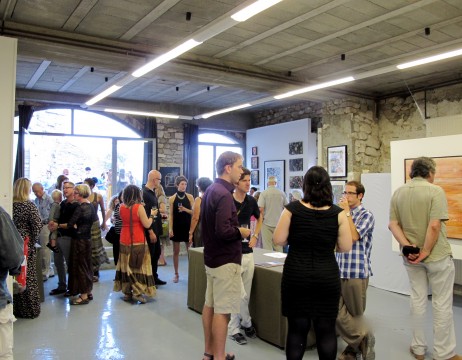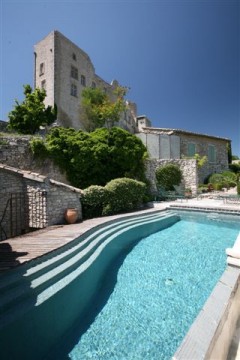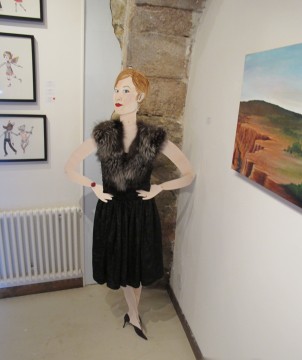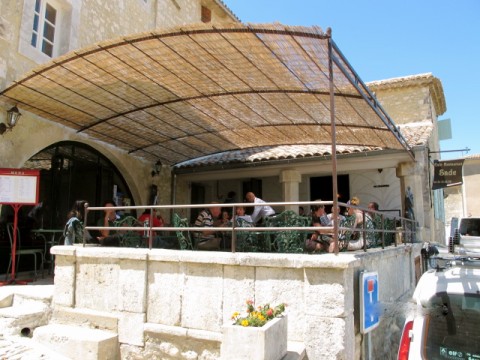Fact or Fiction? The village of Lacoste has 450 residents as noted in an August 2009 article penned by a reporter from the Paris bureau of the New York Times (NYT). True or False? Referencing the same piece, in the winter the “local population drops below 100”; in other words, over 350 seasonal residents flee the village. Final tidbit. Is Lacoste located in the “Luberon river valley” (NYT) or is it the “Calavon river” that traverses the valley. It’s the latter. For the first two items, read on.
Tourists stepping into the streets of Lacoste experience a curious sense of relief that they have tripped upon a movie set of the perfect stereotyped Luberon village only to discover that all the actors and the crew have vanished. Under azure sky, couples wander empty streets — there are only four, three stone-paved and one paved, that lead them anywhere — and then straggle up the steep slope of the Rue Saint Trophime, arriving to the hilltop next to a château , once inhabited by the Marquis de Sade and closed to visitors, to gaze at the valley below, before descending. Tour ends.
Linger a bit in Lacoste and unobtrusive observation kicks in: this is an empty place. So how to deconstruct the NYT numbers? Flash on the web site of Lacoste where it lists a population of 446 and consider this: the commune of Lacoste has a surface area of 2,640 acres. The ancient biscuit-colored picture postcard hillside village covers an area of only 10 acres.
Specifically, confusion arises due to the incongruity between the sleepy commune and the moribund village. A PVB survey of year-round residents in the old village numbers about 37 along with a handful of seasonal residents. An agoraphobe’s paradise.
Four times during the year, the hillside is repotted with a decidedly anglophone flora. A caravan arrives from the Marseille airport freighting students and their instructors from the Savannah College of Art and Design (SCAD). The flock teems with the exuberance of kids unloading at an amusement park with chaperones, and in a sense Lacoste will be their exclusive playground for an eight-week session. Their presence suddenly augments by 60 to 70 the village population.
A calculus of tongues: Take into account three anglophones that reside in the village and factor in the American students and staff; you conclude that for three-fifths of the year the predominant majority of residents speak English. And among these anglophones only a handful speak French. An improbable reality: English is mostly spoken, the American kind mind you, most of the time in Lacoste. Now that is a neat inversion that you won’t find in any tourist brochure. Only for a few weeks in July when Pierre Cardin puts up more than a 100 French speakers to staff and work the Lacoste Festival does the French language reassert itself.
Chat with the students and they are ecstatic about Lacoste’s hermetic nature. Whereas at SCAD’s main campus in Savannah one has to navigate among seventy buildings scattered throughout the town, in Lacoste there is no intra-urban commute required as students zip smoothly from apartment to classroom to studio to cafeteria to café in a breeze. The buzz of activity in the honey-toned stone structures resembles a hive — an appropriate description for a school whose athletic teams bear the moniker “The Bees” — and it is this hive that infuses students with a communal psychic energy. It’s a cool artsy version of a getaway retreat.
At first blush, what grabs you about the students in Lacoste is their physical urge to “pitch”; they are bracing themselves for the anxiety of their presentations to a future employer, potential or existing client, an art director, film producer, photography editor, fashion pasha, design consultant, ad agency director, corporate c-suite exec or magazine publisher for the zen of commercial art is ABP (always be pitching), and this firm conviction is downright visceral as they are also hip to a brutal reality: loans will not get worked off as a barista at Starbucks or waiting tables in an Italian restaurant.
Oddly, SCAD’s presence in Lacoste is discreet. No signage entering the village announcing the school’s outpost. Small placards on doors, when closely viewed, note a SCAD dwelling. Hanging from SCAD’s tony residence hotel on Rue Basse is one sign visible, perhaps for clients to spot upon arrival. The studios, classrooms and quarters are sequestered behind locked gates and heavy doors. Students are never sporting school logos or colors on tees or sweats — a ubiquitous fashion choice on American campuses — and the topography prohibits skateboards, inline skates and bicycles. The curriculum sans heavy textbooks ices another accoutrement of campus life — backpacks. It is only during the end-of-quarter expositions when SCAD peels back its protective cover to reveal the warm stone interiors of studios and sumptuous views from gorgeous terraces.
The history of contemporary Lacoste dates from 2001 when Pierre Cardin, patron of the arts extraordinaire, purchased the château, and in 2002 when SCAD, the world’s largest exclusively arts college where no student ever has to sweat out an organic chem final, assumed control of a Lacoste art school, originally founded by Bernard Phreim, an American ex-pat artist.
Graced with financial resources and fundraising prowess, SCAD has made substantial improvements to a swath of 35 buildings on the hillside below the château, recently completing a major makeover of a spacious building “the Phreim ruins” and hosting a gala benefit in Paris last fall to finance the conversion to student studios of the former stables of the Marquis de Sade outside the village limits. (A map of SCAD’s facilities can be downloaded here). Thought: SCAD employs “Phreim” as a brand, and M. Cardin uses “Sade” in the same vein, making any merger linguistically unthinkable.
Since purchasing the château, Pierre Cardin has bought about 46 structures in Lacoste, a swath that extends along Rue Basse in the lower part of the village. In effect, SCAD and M. Cardin account for between 65% and 70% of the surface area of the ancient hillside village.
The most appropriate adjective that comes to mind to describe the current state of M. Cardin’s projects in Lacoste is “pre-gentrification.” Beginning with wealth distribution — paying more than market value for semi-derelict houses (a veritable windfall for the sellers and a source of envy for those who remain) — M. Cardin has invested more than $30 million in Lacoste, a significant portion devoted to hollowing out the interiors and engaging in mind numbing tasks of installing new plumbing, wiring, walls, floors, ceilings and windows. Of the two hotels due to open at a future date on the Rue Basse, a hotel du bureau (without a restaurant) underwent the stupefying shaping and manicuring of every room by stone masons. Among M. Cardin’s holdings, two buildings function daily: the Café de Sade and the Espace de Costa, the nerve center for coordinating projects and festival information. Gentrification’s next stage: the crew and the actors take their cues from the metteur-en-scène M. Cardin, who gets not directional fee mind you, and assume their new roles to incarnate the village with vitality.
Pierre Cardin is a hands-on patron, and he often pops down from Paris to oversee work. Just this weekend, casually attired, he was scooting about the Luberon valley in a hoopdie Renault, a personage without ostentation. Humility being a virtue, he owns no urge to parade his feelings or his plans; he is into renaissance sort of things. Among the movers and shakers in the Luberon valley there lies a reservoir of immense affection and gratitude. And as for the relationship between M. Cardin and SCAD, they get along like sophomore steadies.
In a curious way Lacoste is denuded of Frenchness: no bakery, no épicerie (small grocery) and no wine shop. No pharmacy, no bank, no flower stall and no ATM. Only from early spring to fall when there is a farmer’s market on Tuesday’s morning does the village reawaken. There are two cafés that bookmark the Rue Basse, which traverses lower part of the village: the Café de Sade, owned by M. Cardin, a modern establishment with a terrace and a dining room, and the Café de France, opening April 1 until late fall, at the western end that is a funky fave of SCAD students with its splendid view although in need of a major touch-up. In fact, comparing the decor of the two cafés offers a kaleidoscope for viewing the pre-Cardin and contemporary-Cardin Lacoste: a ratty ramada and used lawn furniture vs. bamboo canopy shading iron-wrought chairs, for starters.
At present, Lacoste is not an art colony. When the village was in semi-ruin, artists took up on the cheap in derelict houses in which no one else would reside. The village once had a celebrity resident: the English playwright Tom Stoppard who came to the village to write and relax in a stunning house nestled beneath the château that is now owned by an English couple and on the market. Today, the only gallery in the village is operated by SCAD and it’s really an exhibit space given the total absence of street traffic. Gallery hopping is best pursued in Gordes or Lourmarin.
Artistic activity is the SCAD student body plus one, the one being the wry ironic Dan Adel, an American who at first sight strikes you as a displaced New Yorker. In fact, he is hardcore Lacoste year round. After Dartmouth, the National Academy of Design and Hunter College in New York, and making his mark as a painter in New York – Arcadia Fine Arts in SoHo has represented him since 2001 – love came calling when Dan wandered into a café in Vaison-la-Romaine in the northern Vaucluse. When casting about for a studio and love nest, his inner artist resonated with his artistic spirit of SCAD and Lacoste.
Renown for his clever piercing illustrations that have graced the covers and pages of major magazines (Time “Man of the Year’ in 2004 for one), Dan is protean: his oeuvre encompasses oil paintings, portraits, watercolors and photography. Dreamy images of the Luberon landscapes are available at his studio on Rue Basse. As of late, he added ‘père’ to his resumé of accomplishments.
Another Anglophone, lively spirit and chronicler of the small dramas of village life is the Irish poet and writer Finn McEoin, a sober-as-a-stone vegetarian who tends to the plant life and verdant terraces at SCAD.
An ardent advocate for Pierre Cardin’s renaissance of Lacoste, Finn has taken on a few slights and unwelcome gestures from locals, such as finding a bullet in his mailbox. His and his wife’s peripatetic adventures from England to New Zealand and to the Luberon are recited in his book “Two Suitcases and a Dog,” a narrative that evokes Daniel Patrick Moynihan poignant reflection: “I don’t think there’s any point in being Irish if you don’t know that the world is going to break your heart eventually.”
In the states where art education is big money, SCAD is a hugely prosperous affair run by a family for whom Lacoste is not only a hive, it is a honey pot along with three other campuses. More than 9,000 students pour into the pot in excess of $40K for annual tuition, room and board.
SCAD has taken some hits for its hard-driving management style that invokes unorthodox hiring and retention practices: all instructors are engaged on year-to-year contracts. No tenured faculty. A former instructor at SCAD posits this narrative: Recession or no recession, a glut of art instructors ensure SCAD the best teaching applicants from all over the country. The brightest hired at SCAD come across better offers than a year-to-year deal, and they opt to trade in their mosquito repellent for sun tan lotion in California or flip the backwaters of Savannah for the sophisticated lairs of New York, Chicago, Providence or New Haven. Accordingly, students at SCAD have access to talented single-year faculty and a longer-term middling faculty. Whereas at U.S. universities young professors strive to obtain tenure over a seven-year stretch; the brightest and the most productive are rewarded tenure to cultivate a distinguished faculty. Does this scenario have traction or is there room for debate?

August vernissage at SCAD. "My favorite American movies are Annie Hall and American Beauty," opined the design student (rt.) in the plaid shirt.
That said, until such time that Pierre Cardin animates his forty-odd village properties, the essence of Lacoste, it’s “raison d’être” – besides the mundane administrative functions of a city hall, post office, and tourist office – is to pamper the wanderlust of American art students with sleepovers and a pretty view, an idiomatic peculiar tendency that the French let slip from their consciousness.
Looking to visit: Market day on Tuesday morning, the last two weeks of July at Festival time, and the SCAD student expositions in May and August (see dates below).
Basics

The Lacoste château viewed from the pool of "Utopia," former residence of playwright Tom Stoppard, now on the market by current owners
Espace La Costa, Rue Basse, tel: 04.90.75.93.12, Lacoste Festival 2011 program available next month
Savannah College of Art and Design: Lacoste, student expositions/vernissage on May 27-28 and August 26-27
Dan Adel: Atelier Rue Basse, call for appointment
Finn MacEoin: Two Suitcases and a Dog
Utopia: Property listed at Luberon Sotheby’s International Realty
Two quality restaurants (HCB: see codes in sidebar) near Lacoste:
Le Fournil, Bonnieux, La Bartavelle, Goult.
Reading: “The Pervert’s Grand Tour,” Tony Perrottet, Slate







